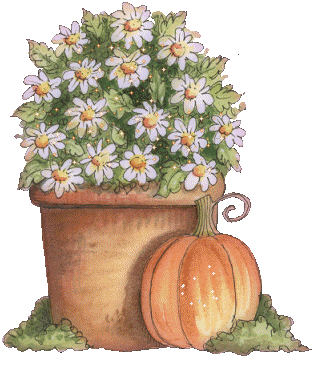a peek into my 🌻 gnōden 🧠 [analog edition]
This post started off with the idea of documenting what I’ve loosely referred to as my ‘second brain’, i.e., my system and tools for noting down thoughts, ideas, reflections, etc. (this post still is that, for the record). But the more I wrote about the details of my various notebooks and how I use them, the less meaningful and more nebulous it felt. And since I see this idea as part of my ongoing journey of repairing my relationship with knowledge/information (i.e., how I interact with it, how it guides my decisions, what knowledge means to me), I felt the need to first establish an ethos/theory to this madness if you will, to share what all of this represents/means to me. I feel like not doing so runs the risk of reproducing content that people who are obsessed with systems and organisation (i.e., me) consume for the endless and misguided pursuit of self-optimisation and perfection. Yeah, this is not that.
wtf is a gnōden?! 🤨
I initially wanted to call this a ‘cognitive garden’, but after breaking out of my hyperfocus of writing this post and spending a couple of days to think about what I wrote, that term just doesn’t sit entirely right… so I came up with a silly, whimsical synonym for it. So with my endless pursuit of systemising and organising what’s in my brain with no satisfying resolution in sight, I have somehow wound up coining a new term →
This little journey started with me, as usual, feeling the need to set up an elaborate notetaking system before I started reading any new books. Chatted about this with a friend and was introduced to the concept of a digital garden. This was where the first seed was planted 🌱 -

The deeper I went into the rabbit hole1 of mindful consumption, the more I resonated with the use of ecological terms as a metaphor for how we engage with the world. While scientific jargon bears limited practical understanding and terms like ‘second brain’/personal knowledge management2 have been inevitably tied to productivity/hustle culture, ecological terms instead signify knowledge and information as organic to (human) nature. Rather than self-centering our relationship with knowledge as one of constant (micro)management (usually for an output), it also highlights what knowledge does for us and others. It reminds me that systems are not inherently sterile and mechanistic, but instead have a life of its own that you work with to help nurture your curiosities.
but why even come up with a new term?
Apart from moving away from mechanistic jargon, I also felt like the terms we currently have are not well-defined and broad enough.
A gnōden, or cognitive garden, is a representational space of your mind, or more specifically, your cognition (i.e., thinking, knowing, understanding, etc.), that like a garden, is intentional (/planned) and cultivated for the gardener’s enjoyment and personal growth.
Consists of an ecosystem - organisms (e.g., knowledge, thoughts, tasks, projects, etc.), some planted by the gardener, some naturally emerging from an initial ecosystem, that interact with the environment and with each other, that ebb and flow organically while also being mindfully tended to by the gardener
Is also communal (i.e., the environment) - where seeds and tools are exchanged (e.g., sharing facts/resources), replanted (e.g., adopting ideas, being inspired), or planted with the help of others (e.g., collaboration)
A more personal rendition of the metaphorical concept of information ecology
The word ‘cognition’ originates from an Indo-European root word ‘gnō’, which means to know. I thought it was a fitting way to shorten and whimsy-fy ‘cognitive garden’ because:
We’re going back to the diverse roots of the English language, and we always say yes to decentring Eurocentric context
It forms a lot of other words relating to knowledge and knowing, which makes it fitting for the broadness of the term
Reminds me of gnomes

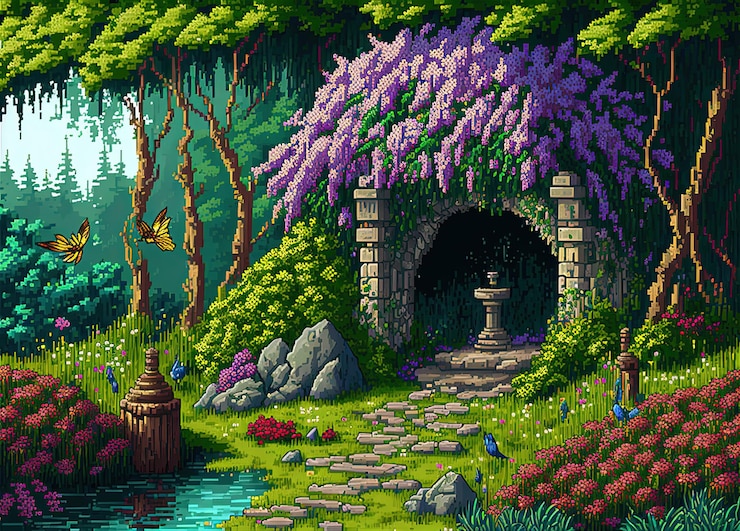
As I’ve mentioned, I initially titled this post ‘my second brain’, then got a bit stumped when I was trying to provide a definition of what exactly is a second brain. Creators in the productivity space refer to it as a system, a solution to information overwhlem, but are often unclear in explaining what it is as an object, or what it represents. Does it represent how you manage, consume, reflect on, connect or share information? Is it all of the above or does it only serve one/a handful of functions? What kinds of information does it manage? In Ali Abdaal’s video (linked above), he considers calendars and to-do lists as part of your second brain, but spends the rest of the video explaining how to capture thoughts and ideas, not tasks. So what is it?
Then I thought - is this my digital garden? But it’s not… entirely digital. A lot of what I consume is digital, but how I manage that information is mostly analog. And similar to the concept of a second brain, it largely focuses on thoughts and ideas that are directly derivative of the media we consume, and nothing else. I hope I’m making sense.
so which part of my gnōden am I sharing?
Hence the term gnōden/cognitive garden is meant to be vague broad, and in the rest of this post, I’m going to share3 how I manage my garden. In other words, I’m going to zoom into the various [analog] ecosystems I have set up cultivated that help me manage the knowledge/information I encounter - i.e., stuff like what type of information goes where, when and how they are categorised and archived. There will be tidbits of how these systems facilitate my consumption practices, how I reflect on incoming information, or how they connected, but more detail will be relegated to future posts as part of this ‘cognitive garden’ series (e.g., my notetaking methods).
Another reason why I’m fond of ecological terms is that these ecosystems are not permanent, and they’re not meant to be. Because systemising and organising things is an actual hobby of mine, the conflict between believing that I can ultimately reach organisational nirvana/‘planner peace’/etc. and conceding that my systems will always evolve is especially salient and exhausting. Giving myself the vocabulary to say that - yeah, these ecosystems will inevitably change with the seasons, helps me enjoy working on these changes as a hobby rather than a race to perfection.
Because at some points in my life, more structure might be welcome, and I’m more likely to have the headspace to manage multiple systems. At other points in my life, it may get busy, I may only be able to handle a singular notebook or two. A garden tends to liven up and require more work in the summer, while plants wither and the ecosystem takes a break in the winter. There will never be a one-size-fits-all!
My theoretical preamble is finally done! It is still a working theory4, but I hope it makes the content below more interesting, meaningful and digestible. All of my notebooks and stationery showcased below are organised according to their ecosystems, i.e., key functions. I might elaborate a little on how each ecosystem works, but like I’ve said, more detail will probably be in future posts!
second brain
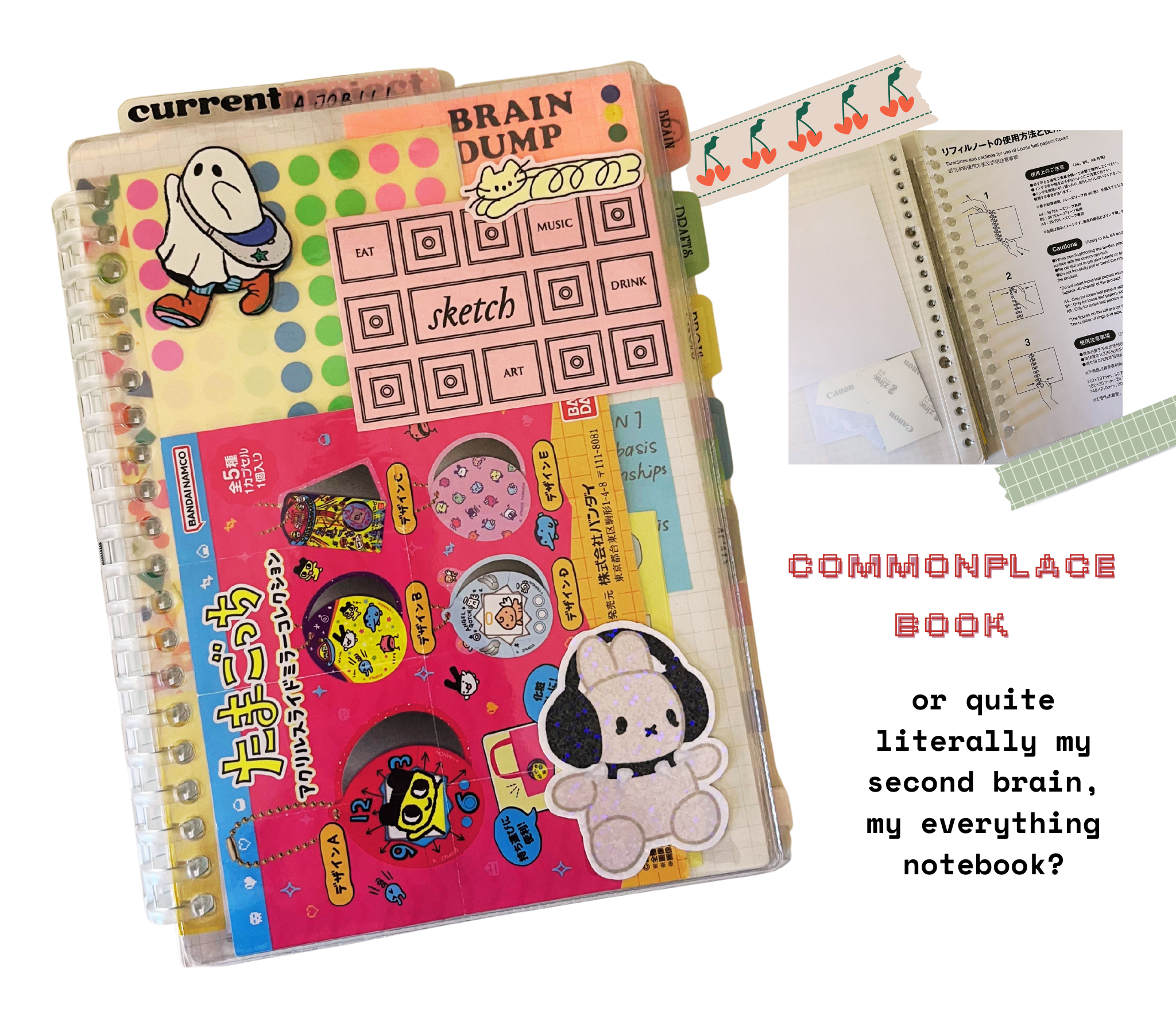
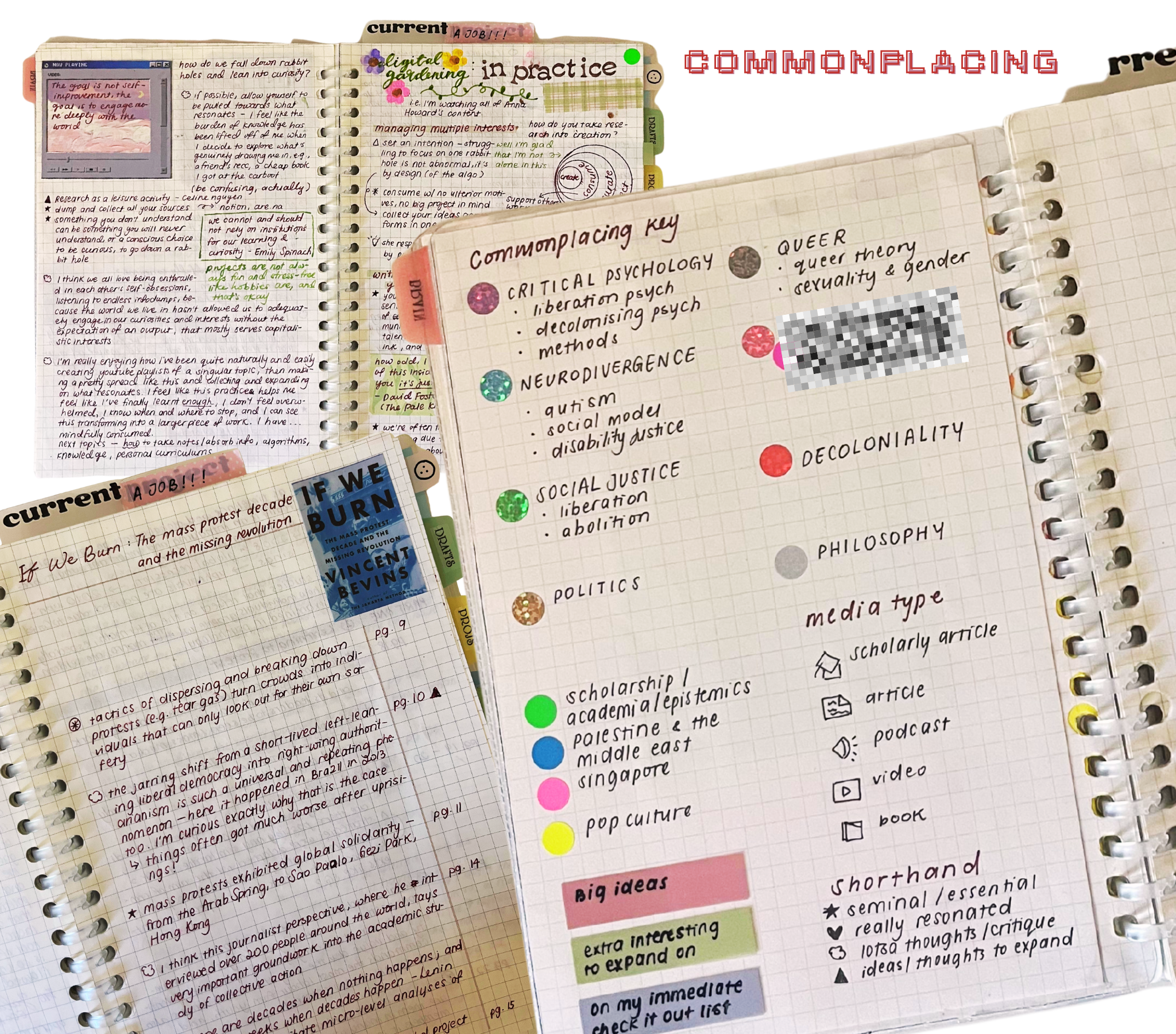
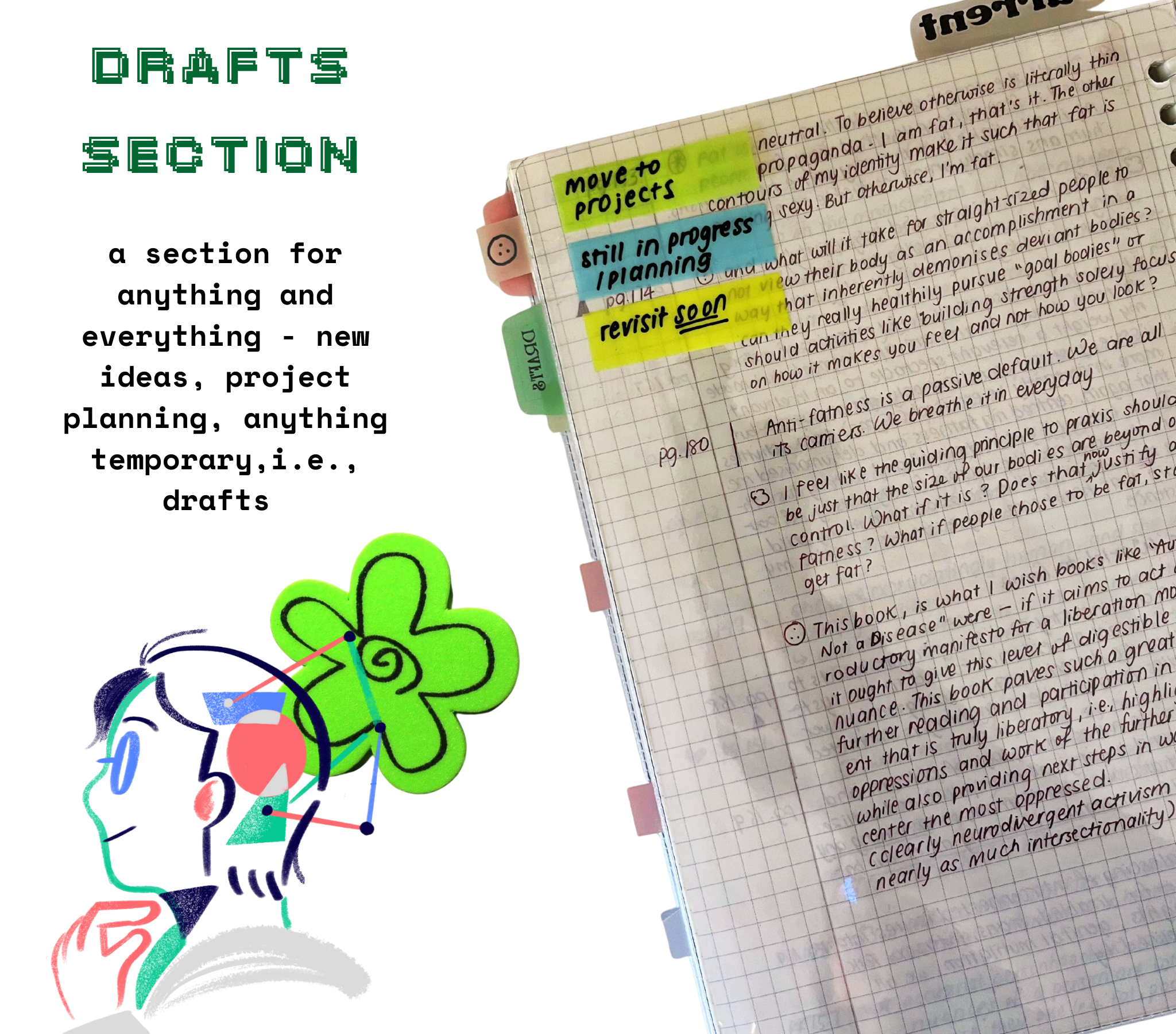
notebook: muji’s “cover for loose leaf paper - a5”
This notebook deserves a moment of appreciation 👌🏼 I couldn’t care less for those trendy louise carmen systems when you have this - basically, it’s a refillable spiral bound notebook, similar to these ones from kokuyo. It works like a binder, where you pull apart the rings and refill it with paper. I love it for several reasons - I can re-position and archive my entries, use whatever paper I like, and bonus - it’s cheaper than the kokuyo ones (and less clunky, has more of a notebook rather than binder feel). This is perfect if you want the flexibility of a binder, but hate how binder rings get in the way of writing.
paper: muji loose leaf or tomoe river/sanzen paper (grid)
The sanzen paper’s a little pricier, but it has been growing on me lately since I’ve been using fountain pen more frequently… I could really go on a whole other tangent about how much I love fountain pen paper. the ink glides on so smoothly, there’s no ghosting or bleeding, and yet it is so thin and durable 👌🏼
This, this is the magnum opus of my brain, the very tool that allows me to engage deeply with the world. My other systems would not exist (apart from keeping track of mundane tasks or reflecting on baseline emotions) if I don’t have this to write down and reflect on nearly everything I encounter.
I will actually have a mental breakdown if I lose this, it’d be like losing your phone along with your entire photo gallery. I’ve split it up into four sections:
BRAIN - where I commonplace, i.e., write notes about the media I’m consuming, highlighting stuff that has captured my attention or deeply resonated. I have quite a complex coding system that changes every now and then based on the topics I’m interested in (my dividers are cut down from A4 folders, so I can always make and insert a new key5), and fortunately it has been working well! It’s fun to label all of my notes with sparkly labels
DRAFTS - I guess this is the analog verison of my notes app. anything and everything that is uncategorised, short-term and/or not set in stone goes here
PROJECTS - notes pertaining to anything I’m working on that has an end outcome/output and deadline. Usually ranges from research papers I’m writing to elaborate and handmade birthday gifts
AREAS - distinct from projects, this section houses notes on stuff I’m working on that is ongoing and doesn’t have an end (unless I leave that role/responsibility). For example, I manage a statistics education blog, so everything pertaining to that goes in here. This distinction between a project and an area is adopted from Tiago Forte’s PARA method
ACADEMIA - self-explanatory! while in my undergrad, this housed notes written for my assessments. Now it houses stuff like conference/webinar notes and postgrad planning. in the future, hopefully this will house my PhD notes, though I have a feeling I’d need way more space.
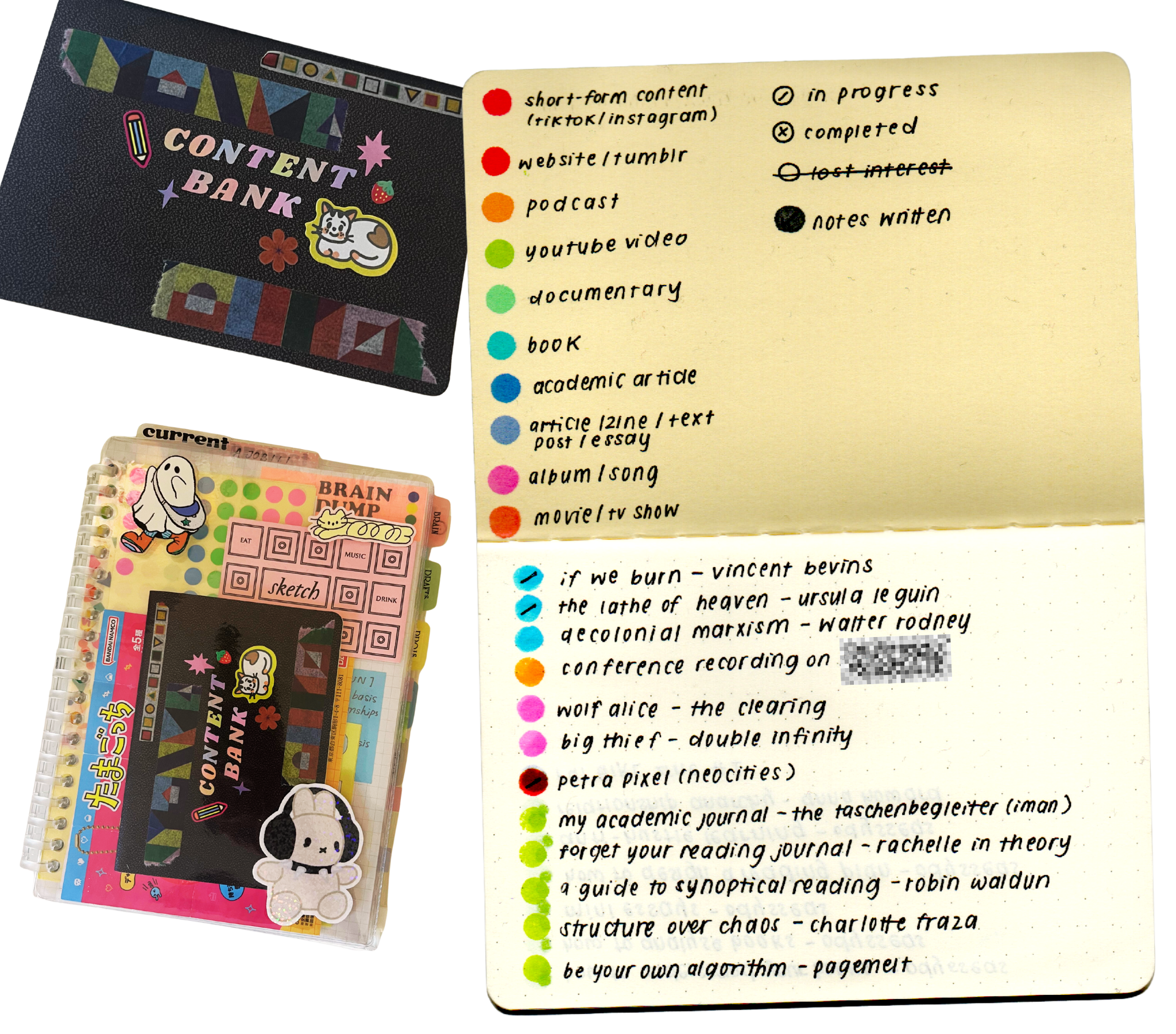
notebook: muji passport memo
Hoarded a bunch of these mini notebooks when I first started my traveller’s notebook passport system a couple of years ago, partly driven by panic after a staff member mistakenly told me they were discontinuing these notebooks. No… they’re still very much alive.
pens: tombow playcolor dot
I bought a whole set of these really cool pens that have a circular stamp on one end and a regular pen on the other, and have never found a good use for it until recently. They remind me of those crayola stamp markers, but for stationery-obsessed adults.
This is my content bank! I just started this a couple of days ago, inspired by this video. for now I guess this part of my system is experimental, but I really hope it sticks. over the past couple of months, I’ve tried various methods of saving and curating the content I want to consume, but I felt like they didn’t do a very good job of helping me break out of my tendency to obsessively collect. So far, physically writing it down in a small notebook (that acts as a companion to my ‘everything notebook’) has made me more mindful of not overfilling it, which then allows me to bring the stuff I want to consume most to the very front of the queue. The intended process:
Whenever I have cleared my queue and am craving for more media to consume, I spend an hour or so looking through the stuff I’ve saved across various platforms (tiktok, conversations with friends, my bookmarks in notion, lists of recommendations in my planner, etc.) and pick out the ones that catch my interest the most and write it in this notebook. Any time I’m in a consuming mood, I consult her!
planning
notebook: muji’s “cover for loose leaf paper - a5”
Same as my second brain notebook! I love this notebook binder so much that I have at least six of these in different sizes. And I’ll probably get more as my analog system grows. Though the one gripe I have about them is that the plastic covers warp over time, and they’re impossible to flatten, hence why I’ve created my own clear cover for my second brain notebook.
I’ve never been able to stick to a pre-printed and/or dated planner. It just feels like a waste of money and paper for me to be leaving gaps and random time jumps, so I thought I’d just have a refillable system that I can use to manage my tasks as and when I need to.
I don’t use this super often - when it gets really busy I just use a digital calendar to time block. Anyway, this is how I’ve divided my sections:
OVERVIEW - currently houses a (blank) project dashboard/matrix and monthly overviews (inserts also from muji). Only ever becomes active when I’m juggling multiple responsibilities and deadlines and absolutely need to lock in
TO-DO - a running to-do list, mostly for non-urgent and sorta random tasks. As simple as it gets - write the date + task
WEEKLY - a hodge-podge of whatever I’d like/have to get up to sectioned by the day, along with any fleeting thoughts and progress updates, all written on blank grid paper. Sometimes, but not often, I time block
LISTS - this is like, the second in queue to my content bank, and extends to personal projects and hobby ideas I’d like to work on. So far, I’m documenting my crafting, journalling and organisation ideas, and my reading and media recommendations.
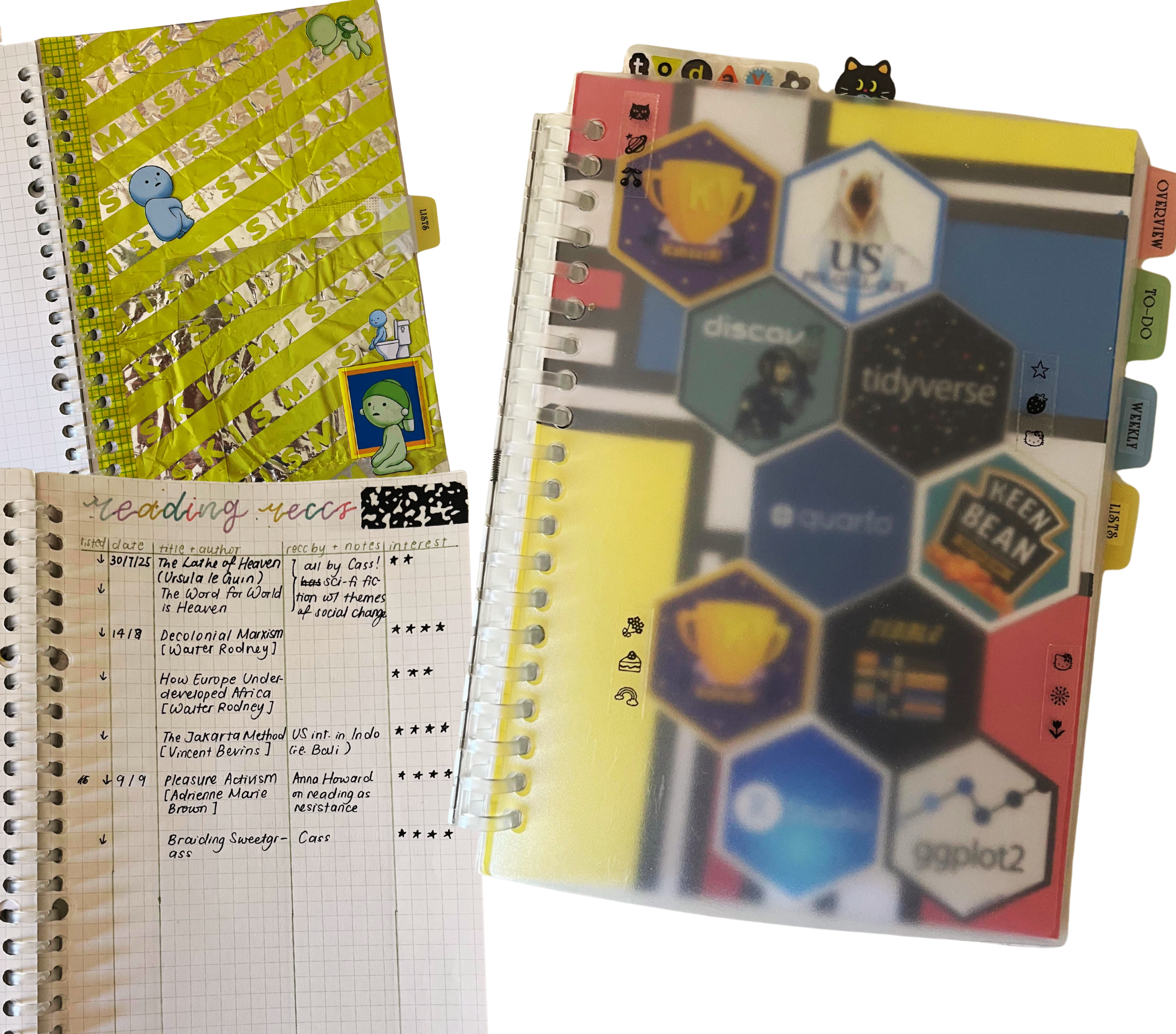
notebook: kinbor weeks 2025
A very affordable and good quality hobonichi dupe. I fell for the hobonichi hype once, I still love their products and tomoe river paper, but knowing how I’ll never be able to fill every page, I know better to just admire from afar 😅. This only costed me £13-15 (versus ~£35), and uses sanzen paper, which takes fountain ink just as well.
This planner is kind of a low commitment, experimental and fun part of my garden. I feel the hobonichi itch literally every year - I’ve never been drawn to the weekly spread on one page + blank on the other layout, but after seeing so many cute spreads on youtube and pinterest, I wanted to see whether I’d like it and how I’d use it. The weeks designs in the 2025 collection weren’t super appealing anyway, so I settled for the Kinbor dupe.
It’s… dead. I’ve stopped filling it in in March (makes sense, that’s when uni started to get really busy with dissertation writing), so there’s a 6-month gap, and the other pages (e.g., monthly and yearly overviews) are mostly blank, so I might6 not be repurchasing.
But I did enjoy using it to condense my week, so I’m trying to revive it. When this was an active part of my garden, I liked how it gave me the opportunity to be artistic with my spreads when I didn’t have the time to do full journal spreads.
during uni:
I’d write a summary of my day + any appointments on the weekly overview
For the blank page, I’d list out my weekly tasks (which were pretty repetitive/predictable) and assign which day to complete them + track my media consumption + fill in the remaining space with a weekly reflection
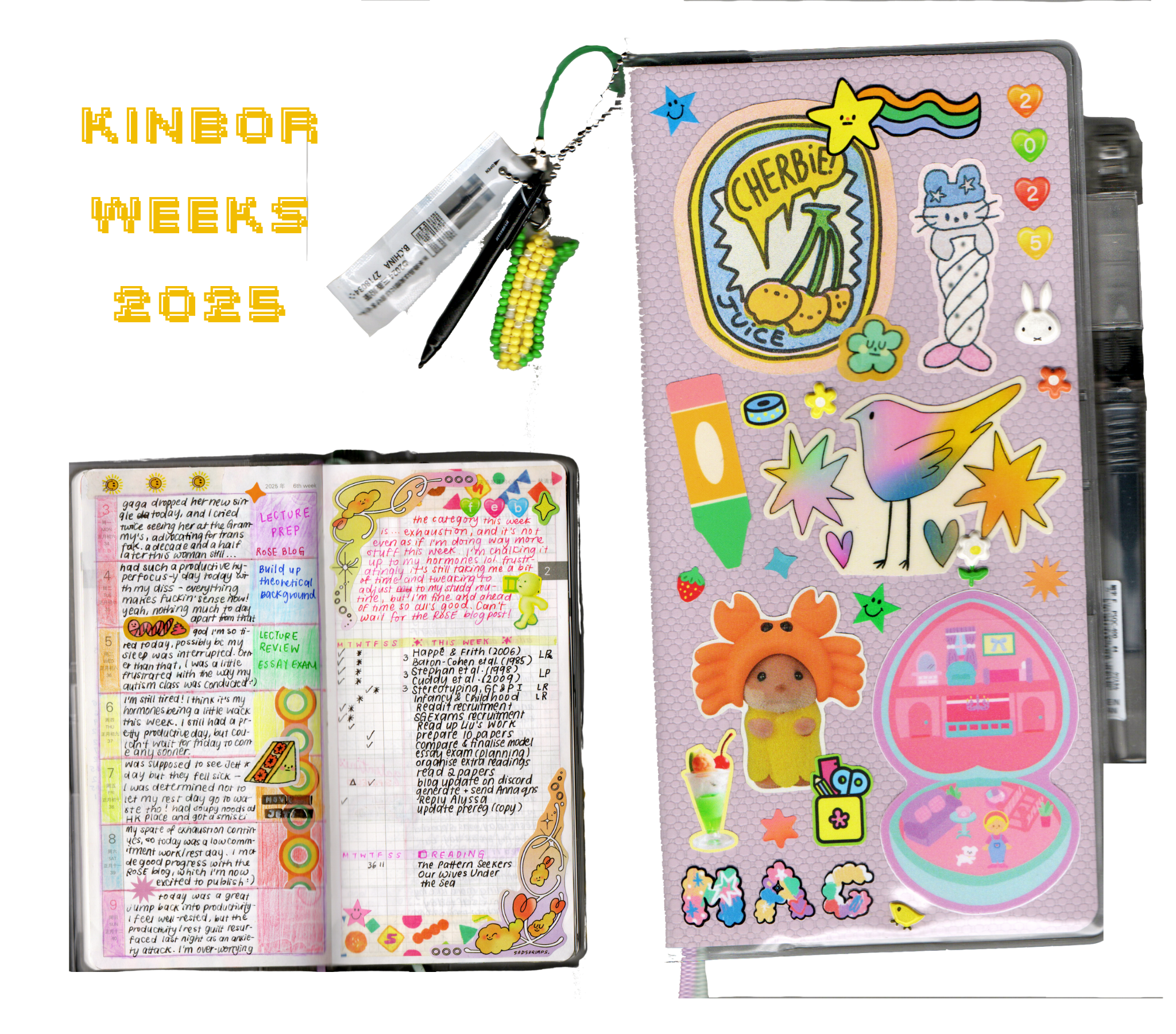
right now:
I’m yet again losing my perception of time and memory! So I’ve been drawn to document my days again, inspired by The Cass Report and her journalling practice of simply writing down what she’s done in a day.
So I’m thinking of following a similar layout as I did in the past, but more focused on what I did for the weekly side, and the media I have consumed + maybe track a couple of other things for the blank side. No idea about the other pages, maybe more media stuff? Either way, I’m okay with it being blank and/or bare.
Which reminds me… I’ve forgotten to write about my day yesterday (26 Sep).
journalling
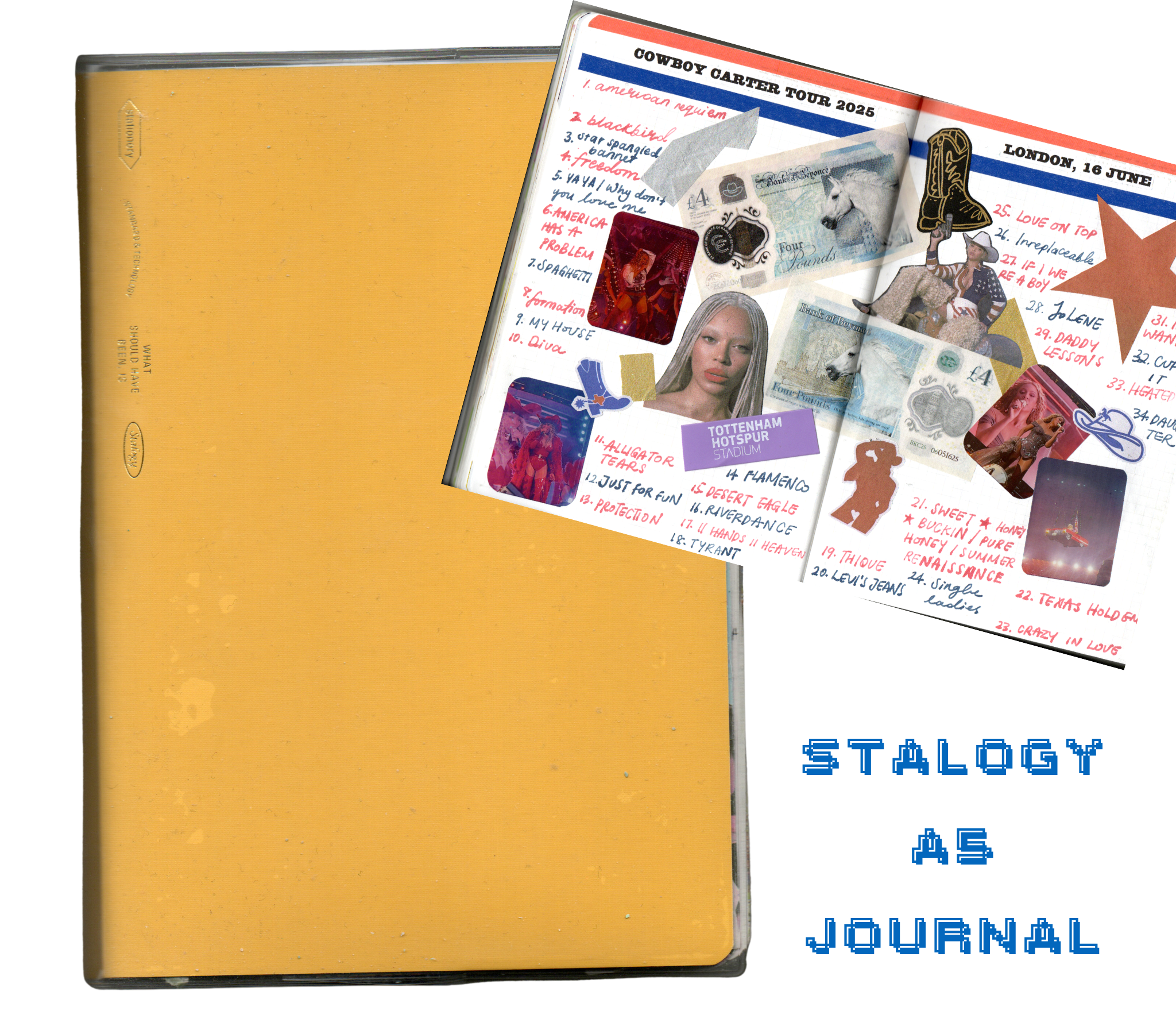
Very personal stuff in here, but I also have more creative spreads that I might end up sharing more of on this website! There’s a small one on my about me collage in my homepage, and the one you’re seeing in the picture above is what I did to document my experience at Beyoncé’s Cowboy Carter Tour!
Haven’t been feeling very drawn to junk and memory journalling lately, so it has mostly been stream of consciousness and processing emotions entries. Writing them has been very enjoyable and motivating with a fountain pen.
notebook: stalogy 365 days notebook (a5) - grid paper
This is an expensive notebook… but it’s massive (365 pages) and also uses tomoe river paper, so I’d say it’s well worth the price tag. Bought it a couple of years ago hoping to use it as a bullet journal, but I only managed to set up less than five pages. So I just ripped those pages out and now it’s perfect for journalling. I wish they had versions with cream coloured paper though.
My dear diary, my deepest darkest thoughts, my memory highlights, my junk journal, all in this chunky boy. I started this journal on the 8th of September 2024 (a little over a year!) and it’s nearly half full, which to my standards, is honestly amazing progress. I started it because I felt a shift in where I was at in life - before this I used a Midori A5 grid notebook, and looking at the entries, I could literally tell that that was quite a different version of me that wrote in there. It was a version of me that was stuck in a loop of my previous 9-to-5 job that I loved but eventually outgrew. A version of me whose identity felt significantly more limited by her environment, chronic illness and routines. A version that was rule-based, but to a fault (I tried to give that journal very consistent formatting rules). It was where I documented a massive change (moving abroad) while still clinging onto that version of me. Shifts and growth was happening but I wasn’t motivated to document it in that journal, so I jumped ship! Direct quote from my first entry:
I feel like I’m entering a ‘next phase’ in life, one that’s more optimistic, at ease and introspective. I haven’t felt this way in literal years, and the version of me in that journal no longer reflects who I am now. I was dictated by fear, by uncertainty […] it was my fear of confronting the most vulnerable and sensitive parts of myself that led to that journal missing out huge pivotal chunks of my life.
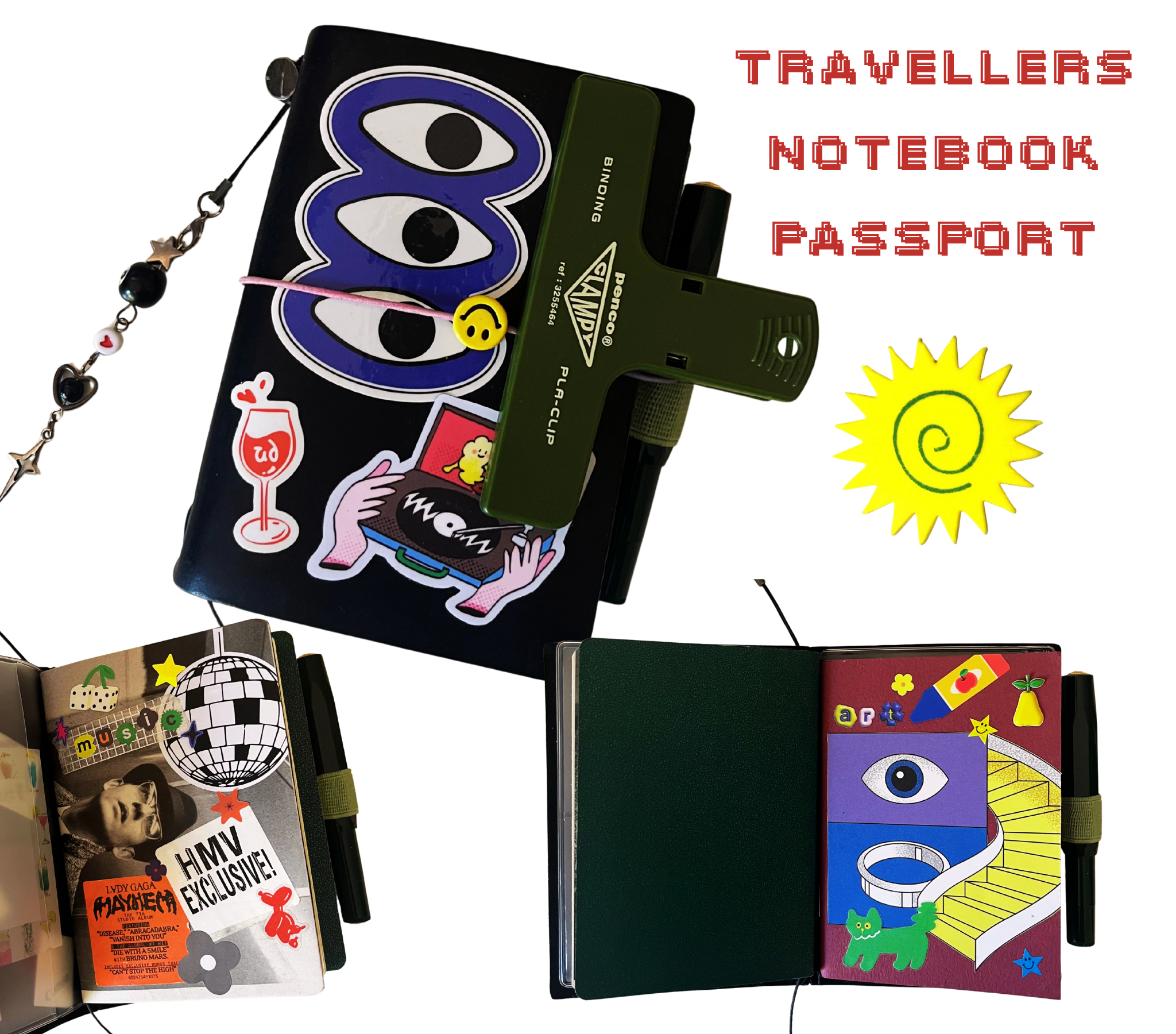
Set this art journal up while in one of my manic-I-need-to-satisfy-a-creative-itch moments. Broadly speaking, I hope to document what artistically inspires me here. With how compact this notebook is, I was also hoping bringing this out with me would motivate me to be less on my phone and be more comfortable with using a notebook in public. Haven’t been very successful with that unfortunately 🥲.
notebook: midori traveler’s notebook - passport size
I hate how slim the regular sized notebooks are, absolutely despise it. It’s such an odd rectangular shape, but this? Such a perfect carry-able size, and it’s actually quite useful for chucking your actual passport in there when traveling. Ended up owning two of this notebook (another one in brown), both gifted from friends! I’ve had them for years but don’t use it very often, so the leather has barely aged 😔.
pens: kaweco sport fountain pen in green, with an extra fine nib and dark red ink
I really wanted to love this pen, and it wasn’t cheap! It’s such a perfect size for the notebook too. But I find it a bit too scratchy. I still try and use it but always just end up defaulting to my gel pens for this journal.
This currently houses three inserts:
MUSIC JOURNAL/LOG - inspired by this video by @spicerycurry on tiktok, I thought it’d be fun to document anything and everything related to music in here! Hers focuses on album reviews, but I also use it keep track of upcoming gigs, and hopefully expand it to catalog my record collection and more
ART - I meant for this to be a catch-all for anything I encounter out in the wild, but so far, it’s still blank. I’m thinking sketches, random ephemera/junk I collect, notes/reflections when I visit a museum, etc.. Also want to try out collecting and printing textures in it with playdough and ink
MISC - for anything and everything else I’d want to write down while I’m out and about, but doesn’t fit anywhere else. Still blank.
archiving
binders: muji pp binder a5
So simple, cheap, and great for archiving. I have two more that I use for storing important documents and recipes.
notebook: muji’s “cover for loose leaf paper - a5”
The refillable notebook makes another appearance!
My archive is essentially split into two systems:
ANALOG ZETTELKASTEN7 - this is a very new addition to my archive that I’ve set up because I was running out of space in my archive binders. This houses everything that was in the brain section of my second brain notebook that I haven’t thought about/referenced in a long time, or is currently parked (e.g., notes on books I’ve paused on reading). Alphabetically organised by topic and shelved on my desk for easy referencing
ARCHIVE - I have two of these binders for everything else that was in my second brain notebook (i.e., drafts, projects, areas and academia sections) and planner that I no longer need easy access to. I don’t really have strict criteria as to when and what goes into either binder, I sort of just go by a queue system of accessibility. The first binder has stuff I might want to occassionally refer to, so it’s shelved on my desk, while the second one (and more once this fills up) is completely archival and has stuff I no longer need to reference (e.g., my planner spreads from like, two years ago), so it goes in my drawer. I review everything as and when my notebooks and binders get too full.
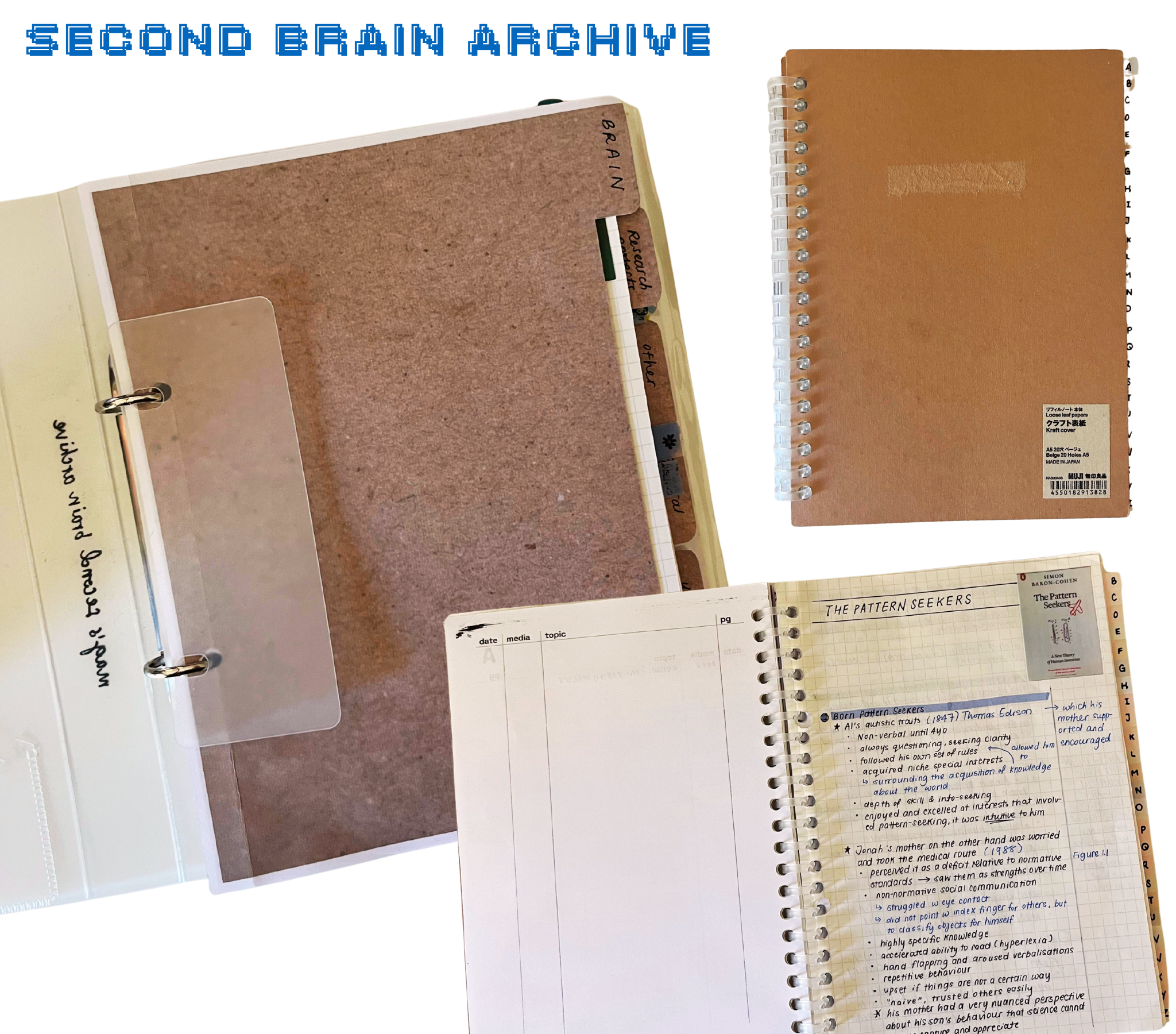
writing tools
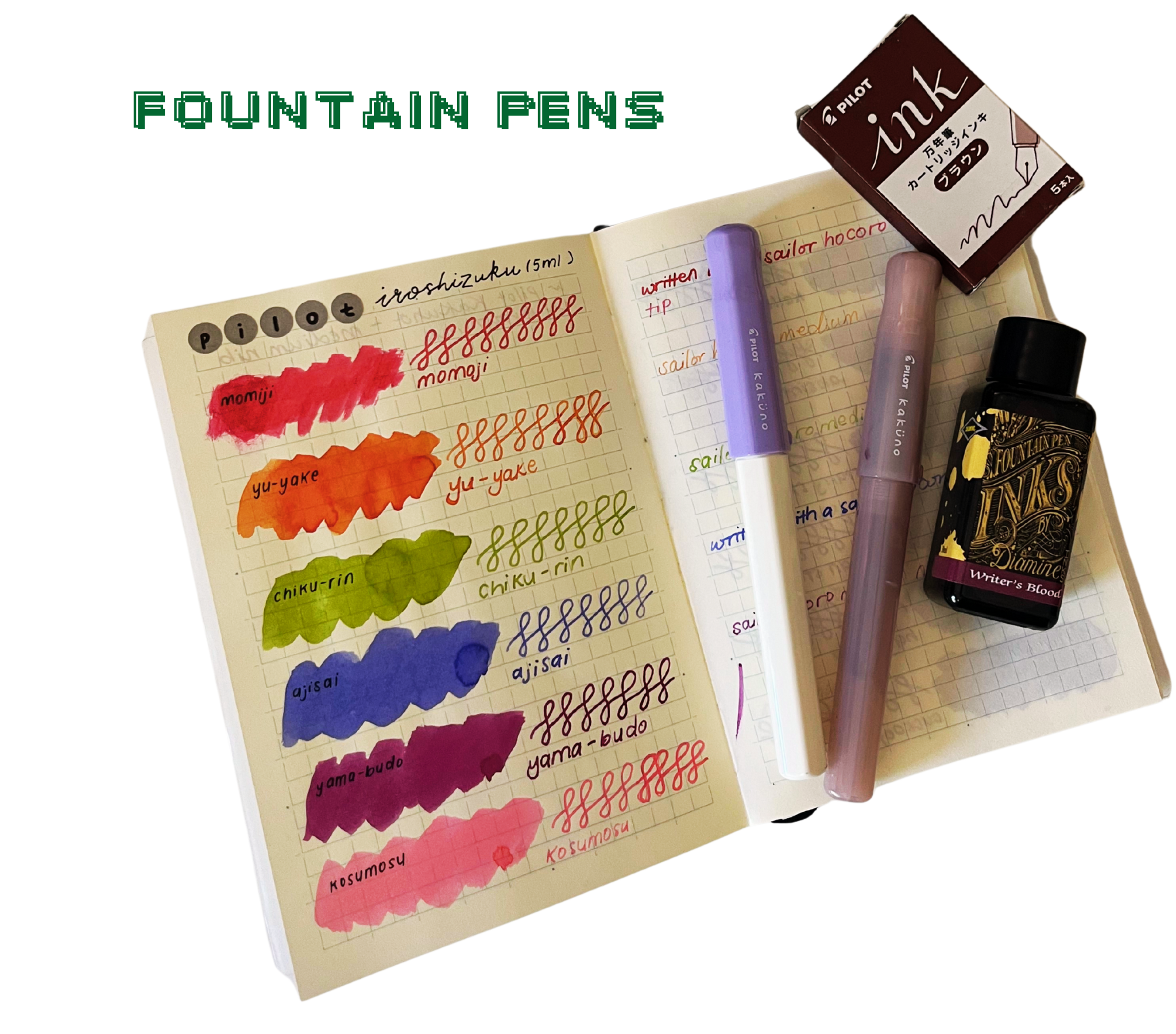
I document all my ink swatches and pen tests in a midori a6 notebook (grid). If you’re looking for a notebook with thicker paper that is fountain pen friendly and extra smooth, I highly recommend midori paper. I didn’t know it was fountain pen friendly until recently! Tiny details like the thickness of the paper really make a difference in what each notebook means to me - because it’s thicker than tomoe river/sanzen paper, it feels like I’m documenting things, creating a gallery of sorts, i.e., of my fountain pens and inks!
I’ve been toiling away at the rest of this post just so I could get to sharing about my newest hyperfixation/special interest - fountain pens8!
I think this deserves another separate post too 😪, but seriously - ever since I got back into fountain pens and properly learnt how to use them, I’ve written exponentially more, so much more. The writing experience makes such a huge difference. Here are the pens + inks on my current rotation:
Pilot Kakuno (Fine Nib) with Diamine ink (Writer’s Blood) - They say that the Kakuno is a great beginner-friendly and affordable fountain pen, but hell, this is an amazing and affordable fountain pen for anyone. The finer nibs are not scratchy at all (I can’t say the same for pens I have that cost twice as much… seriously) and I’ve never experienced any ink flow issues. I think the only con is that the caps are not airtight, so ink dries out slightly quicker. And the ink 👌🏼, is so beautiful9, it has become my primary ink colour (all of the notes in my second brain notebook are written with this ink). Diamine inks are also really affordable and have a massive range of colours, though they’re not archival quality, so you have to be really careful with not smudging and getting water on your writing.
Pilot Kakuno (Medium Nib) with Pilot’s ink cartridges (brown) - This nib and ink colour was my first love (before I introduced the fine nib + writer’s blood ink), and I primarily use this for my journal. Something about the thicker nib and how it makes the ink flow smoother makes it perfect for writing down your stream of consciousness as it flows. Can’t believe I used to be a strictly black + blue ink person, brown and deep red inks are elite10.
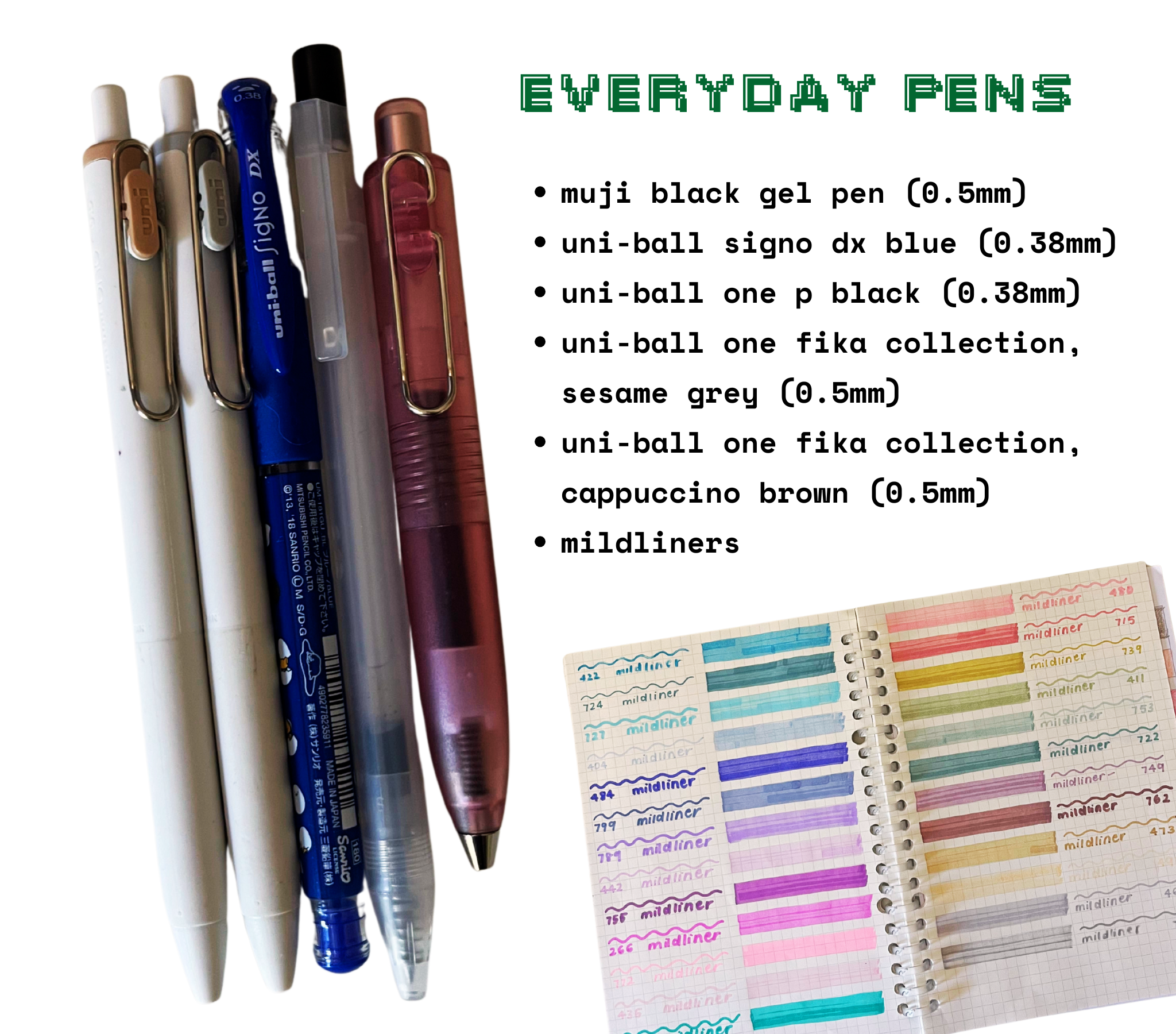
I’ve used yet another one of those muji refillable notebooks to swatch my excessive pen + marker + highlighter + washi tape collection. And yes… I have all 40+ colours of mildliners…
I’m only half kidding when I advised everyone to start throwing money at fountain pens - I’m still a heavy gel pen lover and user! After nearly an entire life of experimenting and finding the perfect pens11, I’ve settled on these. I’ve been religiously using the muji gel pen for the past 5-7 years - never failed me, no ink skipping or drying, always super smooth and juicy, and cheaper than my previous love12. I also love the uni-ball signo in blue for denoting subpoints and additional comments, another cult classic13.
I’ve also recently fallen in love with the uni-ball one series - they have a beautiful range of colours and the ink is super smooth and juicy too. And fun fact - they claim to have the blackest black ink! When I compare it to my other pens, I can really see the difference.
my everyday carry
Which consists of my second brain notebook and planner! I very recently got this nahe general purpose case in A5 while I was in London, which has been on my wishlist for awhile (it’s plastic, but has texture on it that makes it look like leather? I love it), but before this I was similarly carrying all of my notebooks and pens in a cheap A5 case from Daiso.
This is my ride or die setup, these two notebooks powered me through university, through countless of meetings, and made sure I was on top of my shit when I was out and about. If I’m not going to uni/work I like to swap out the planner for my ereader, that way I have the perfect setup for reading + notetaking, preferably at a nice café.
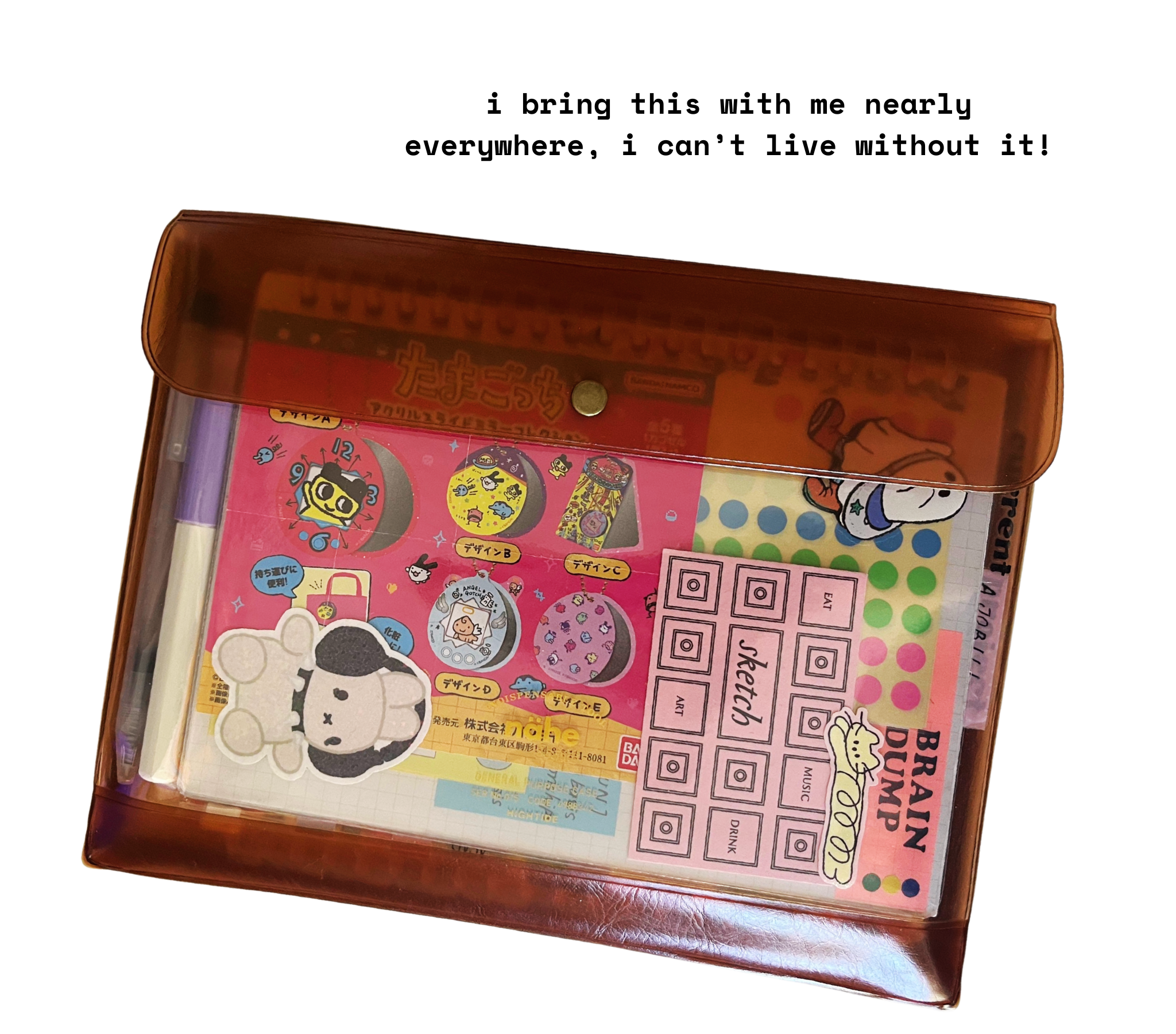
closing thoughts
Wow, this post took me a little over a week to put together14. It has been years since I last put out a labour of love in writing, since I shared about my interests in great detail, and it feels fucking great. I’ve just shown you all the systems I use to keep track of my thoughts, ideas, reflections, tasks, etc., and the process and ecosystem by which I’ve written this post with (which has been entirely digital, more on that in another post) is essentially how I turn all of that into an output. Turns out, this is not an organised chaos after all, but an ever-evolving garden 🌿💭. Now that I’ve shared a zoomed out snapshot of how I manage/tend to my garden, I’ll hopefully zoom into the following ecosystems in future posts:
Consume - how I decide, filter and keep track of my media consumption habits, how I engage with what I consume (e.g., notetaking processes), what it turns into
Reflection - how I use my various ecosystems to engage in deeper reflection, to process emotions, keep track of my life/tasks/projects, memory-keeping, etc.
Connect - how I make sure my thoughts, notes and reflections don’t just exist abandoned in a vacuum, i.e., how I’m trying to connect them to other topics and how that has resulted in new ideas and reflections forming
Share - like I’ve mentioned above, how I translate everything in my brain into outputs that I value and am passionate about.
And thank you to the probably less than five people that have made it down this far 🙇🏻♀️💕.
Footnotes
also, rabbit holes appear in gardens too?! it just makes sense to use ecological terms↩︎
From my brief deep dive into PKM/PIM, the bulk of contemporary research in this field has been centred on employees and organisational productivity (Grundspenkis, 2007; Wright, 2005; Smedley, 2009). Personal information management (PIM) is less sterile and output-focused, and has been researched in various academic displines (e.g., anthropology, librarianship), so I think it provides a great guiding framework. But it being an academic area of study, it’s still a very technical and inaccessible term. Either way, all of these terms are really just giving this:

No thank you 🙂↔︎️…↩︎
Which is another ecosystem in my cognitive garden - perhaps this website, my conversations with friends, academic papers I write/present, etc., represent the bees that pollinate the flowers in my garden, or the wind that sweeps the pollen to others’ gardens 🤔🐝🍃↩︎
It’s semantically the best fitting, but I feel like ‘cognitive garden’ doesn’t roll off the tongue very nicely… So new term suggestions and synonyms (apart from gnōden) are very welcome, along with even more theoretical back-and-forth.↩︎
Again, it’s little features like this that help me anticipate and embrace changes in my systems↩︎
Emphasis on might lol↩︎
I’m using the term zettelkasten quite loosely here - mainly I’m adopting it’s way of indexing items in topical and alphabetical order. My notes aren’t actually singular ideas/thoughts/notes.↩︎
I mean I’m half kidding; it’s been so much fun laying out and explaining my entire garden, but I do love a good nerding out over stationery.↩︎
A friend said it looks like dried blood, which makes me love it even more. That’s so badass and also poetic, that my musings are etched in my blood (figuratively).↩︎
And not easy to find with gel/ballpoint pens! So this is your sign to pour more money down the drain and get into fountain pens if you’d like to become a Thought Daughter :’)↩︎
Ever since I entered formal schooling, so like, 7? The tiny stationery store (and the library) in school were my safe spaces, and every time I’m in a mall I’d wander off on my own and spend nearly an hour at the stationery store, testing all the different pens.
↩︎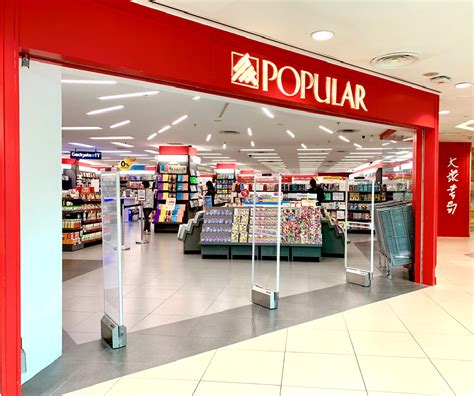
I love how the exact branch of the bookstore that I spent hours in when I was a kid popped up as the first search result Still a really great pen and considered a cult classic in the stationery community, but to be completely honest, can be slightly finnicky (e.g., ink skips and dries after having not used it for awhile).↩︎
I have a theory that geographical differences in handwriting partly boils down to the pens we had access to as kids - literally every Singaporean knows of and most likely has used this pen since they were a kid. To use a pen with such a thin tip (0.38mm when most people in the West are only familiar with 0.7mm tips, and 0.5mm is considered small to them) as we were developing our handwriting probably explains why Asians have such small and neat handwriting 🤔.↩︎
And a sizable portion of that time was spent being self-conscious about my ✨ whimsy ✨, scared to be perceived for daring to come up with a cute but possibly cringy term. Y’kno what -
